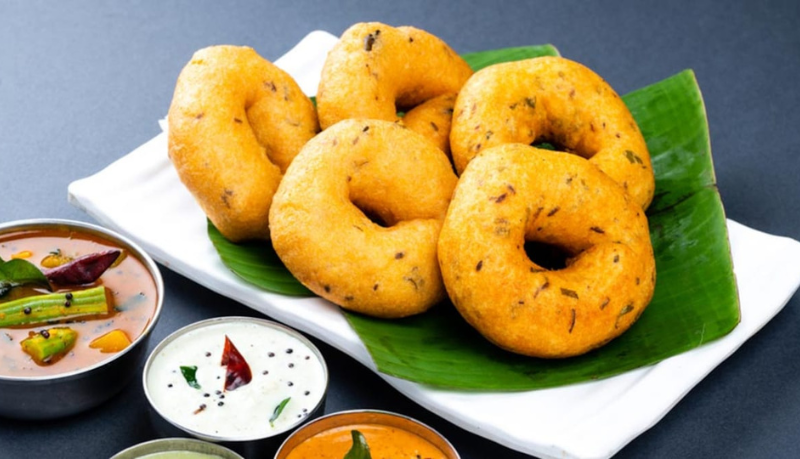Excerpt
Wondering if medu vada is good for weight loss? Find out everything about its calorie count, nutritional benefits, and whether it can be included in your diet plan.
Is Medu Vada Good for Weight Loss? – Get To Know!
Medu vada, a popular South Indian snack, is loved by many for its crispy texture and savory taste. But if you’re on a weight loss journey, you might wonder: is medu vada good for weight loss? Let’s dive deep into this topic and uncover the truth.
What’s Medu Vada?
Medu vada is a traditional South Indian fritter made from urad dal (black gram) batter, seasoned with spices like cumin seeds, black pepper, and curry leaves. It’s typically deep-fried to perfection, resulting in a crunchy exterior and a soft, fluffy interior. Often served with coconut chutney and sambar, medu vada is a breakfast staple and a beloved snack.
Nutritional Profile of Medu Vada
To understand whether medu vada is suitable for weight loss, we need to look at its nutritional profile:
Calories: A single medu vada (approx. 50 grams) contains around 120-150 calories.
Proteins: Urad dal is a good source of protein, providing around 2-3 grams per vada.
Carbohydrates: Each vada has about 10-15 grams of carbohydrates.
Fats: Being deep-fried, medu vada contains around 7-10 grams of fat.
Fiber: Urad dal offers dietary fiber, contributing to about 1-2 grams per vada.
Can We Eat Medu Vada in a Diet?
When considering medu vada for a weight loss diet, it’s crucial to weigh its benefits against its potential downsides.
Pros:
Protein-Rich: The urad dal in medu vada provides a decent amount of protein, which can help in muscle repair and growth.
High in Fiber: The dietary fiber helps in digestion and can keep you feeling full for longer periods, reducing overall calorie intake.
Nutritious: Besides protein and fiber, urad dal is rich in essential vitamins and minerals like iron, magnesium, and potassium.
Cons:
High Caloric Content: Due to deep frying, medu vada has a high calorie count, which can add up quickly if consumed in large quantities.
Fat Content: The oil absorbed during frying increases the fat content, which might not align with a low-fat diet plan.
Carbohydrate Count: Medu vada contains carbohydrates, which need to be accounted for, especially if you’re following a low-carb diet.
How Many Calories Does Medu Vada Have?
As mentioned earlier, a single medu vada contains around 120-150 calories. If you have a serving of two medu vadas, you’re consuming approximately 240-300 calories. To put this in perspective, this is roughly equivalent to a small meal or a substantial snack. If you’re counting calories, you’ll need to balance your intake accordingly.
Is Medu Vada Healthy?
Medu vada, when consumed in moderation, can be part of a healthy diet. Here’s why:
Nutrient-Dense: Urad dal is packed with nutrients that are beneficial for overall health.
Protein Source: Protein is essential for muscle maintenance and repair, making medu vada a good option for vegetarians looking to increase their protein intake.
Digestive Health: The fiber content aids in digestion and promotes a healthy gut.
However, the healthiness of medu vada largely depends on how it’s prepared. Traditional deep-frying can add unhealthy trans fats. Opting for healthier preparation methods, like baking or air frying, can significantly reduce the calorie and fat content.
Benefits of Medu Vada
Medu vada has several health benefits, especially when prepared and consumed mindfully:
Improved Digestion: The fiber in urad dal aids in digestive health, preventing constipation and promoting regular bowel movements.
Rich in Iron: Urad dal is a good source of iron, which is essential for producing hemoglobin and maintaining healthy blood cells.
Bone Health: The calcium and magnesium in urad dal contribute to stronger bones and teeth.
Heart Health: When cooked with minimal oil, medu vada can be a heart-friendly snack due to the presence of healthy fats and proteins.
Tips to Make Medu Vada Healthier
If you love medu vada but are concerned about its impact on your weight loss goals, here are some tips to make it healthier:
Use an Air Fryer: Air frying reduces the amount of oil used, cutting down on the calorie and fat content.
Bake Instead of Fry: Baking medu vadas can be a healthier alternative while still achieving a satisfying crunch.
Incorporate Vegetables: Add finely chopped vegetables like onions, carrots, and spinach to the batter to increase the nutritional value and fiber content.
Use Healthy Oils: If you must fry, use oils with a high smoke point, like coconut oil or avocado oil, which are healthier options compared to traditional vegetable oils.
Portion Control: Enjoy Medu vada in moderation. Pair it with a salad or a bowl of soup to create a balanced meal.
Looking for authentic South Indian food? Try our delicious Authentic cuisine at Yenna Dosa! For more details, visit www.yennadosa.com or call us at 7522909090. Come and experience the taste of tradition!
Conclusion:
So, is Medu vada good for weight loss? The answer lies in how it’s prepared and consumed. While traditional deep-fried Medu vada can be high in calories and fat, opting for healthier cooking methods and consuming it in moderation can make it a part of a balanced diet. By understanding its nutritional profile and making mindful choices, you can enjoy this delicious snack without derailing your weight loss goals.
In the end, weight loss is about balance and making informed choices. Medu vada, with its rich nutritional benefits, can be included in your diet, provided you’re mindful of how much and how often you consume it. So go ahead, savor your Medu vada, but remember—moderation is key!
May 29, 2024



